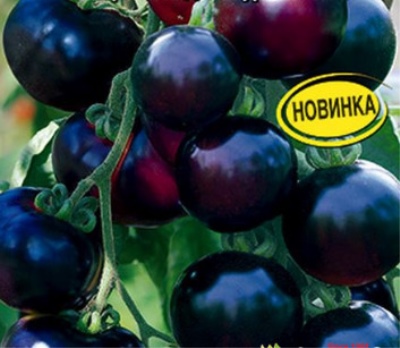
- Authors: V. G. Kachainik, M. N. Gulkin, O. A. Karmanova, S. V. Matyunina, Agrofirma "Aelita" LLC
- Year of approval: 2019
- Category: grade
- Growth type: indeterminate
- Appointment: fresh consumption
- Ripening period: mid-early
- Ripening time, days: 108-115
- Growing conditions: for open ground, for film greenhouses
- Leaves: dark green, long
- Unripe fruit color: dark purple
This tomato variety is called a discovery in the world of selection. Indeed, it can surprise even a gourmet. Tomato Ugolek fully lives up to its name. Its fantastic berries are like burning coals: against the background of almost black or black-purple fruits, a red blush is traced, which is unique, different everywhere. Each tomato has a unique color. But Coal is not only good in appearance - it is also tasty, fruitful, and its germination rate fluctuates at the level of 92%.
Breeding history
Such an interesting variety in all respects was developed by domestic breeders from the Aelita agricultural firm, such as V. G. Kachainik, M. N. Gulkin, O. A. Karmanova, S. V. Matyunina. It happened quite recently. The culture was included in the state register in the Russian Federation and approved for use in 2019. Designed both for open ground and for film shelters in private households.
Description of the variety
Coal is an indeterminate tomato variety with long leaves that are dark green in color. Each brush can form 9 to 12 fruits. At the same time, it has a simple inflorescence and an articulated peduncle.
The main qualities of the fruit
Ugolek tomatoes are amazing precisely for their colors. Even in an immature form, they differ from many others, having a dark purple color, and even a ripe fruit is doubly striking: its color will be violet-red. The shape is quite traditional, it is round, slightly ribbed. The tomato has a small number of nests: there can be two or three of them. The mass of "coals" is small - 65-80 grams. In rare cases, there are more.
It is worth saying that both the shape and color can change taking into account the conditions in which the culture is grown.
Taste characteristics
In addition to the unusual color, the fruits of the Ugolok have an excellent salad taste. Interestingly, against the background of an almost black skin, the flesh of the fruits is bright red, while it is fleshy and sweet. On the cut, it looks very impressive, besides, the fruits are also tasty and healthy. Vegetables are intended mainly for fresh consumption. But they also look interesting in whole-fruit conservation.
Ripening and fruiting
Coal is a medium early variety. The first crop of tomatoes with beautiful fruits can be harvested within 108-115 days after the first leaves are pecked.
Yield
The yield of the Ugolk fruit is also high. In the greenhouse, the harvest of marketable tomatoes will be from 6.4 to 6.7 kg per sq. plantation meter.
The timing of planting seedlings and planting in the ground
As for the schedule for planting seeds of the variety in question, the recommended dates are from 1 to 15 March. The transfer of seedlings to the ground is carried out from May 15 to June 5. Of course, the climatic conditions of a particular region are also of great importance. So, in the southern regions, 40 days are enough for growing seedlings, and in the north, the procedure takes from 40 to 60 days. Basically, planting should be guided by the final cessation of spring frosts.

Growing tomato seedlings is an extremely important process, because it largely depends on whether the gardener can harvest at all. All aspects must be taken into account, from seedbed preparation to planting in the ground.
Landing scheme
The recommended planting scheme for tomato bushes of the Ugolek variety is 60x50 cm.

Growing and caring
Coal seedlings are planted vertically in the ground in a permanent place, the depth should be small, then the plantings are sprinkled with earth. After that, the bushes must be watered. The best way to do this is to recharge. So still young plants will not be nailed to the ground and will not get polluted.
Coal is grown, as a rule, in 1-2 stems. Stepchildren up to 1 brush are regularly removed. The lower leaves must be torn off after the ripening of the fruits for 2 bunches.
It is better to tie it to a vertical trellis; for this, a loop of twine is made on the stem. And before planting tomatoes in a greenhouse at a height of 2 m, a wire is pulled in places corresponding to the planting pattern.




A plant needs different micronutrients at each stage of growth. All fertilizers can be divided into two groups: mineral and organic. Folk remedies are often used: iodine, yeast, bird droppings, eggshells.
It is important to observe the rate and period of feeding. This also applies to folk remedies and organic fertilizers.
Disease and pest resistance
The coal has good resistance to diseases such as apical rot. And also with a long stay on the bush, the fruits do not crack.


Growing regions
Tomato Ugolyok is grown in various parts of the country. The variety has proven itself well in such regions as North, North-West, as well as Central, Volgo-Vyatka, TsChO, North Caucasus, Middle and Lower Volga region, Ural, West and East Siberia, Far East.

























































































